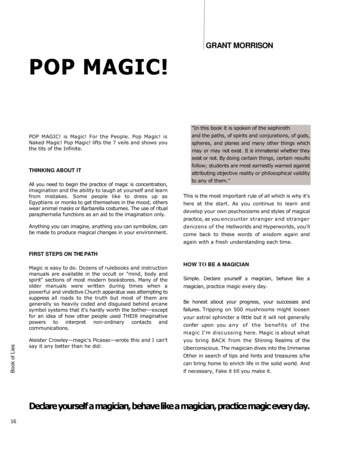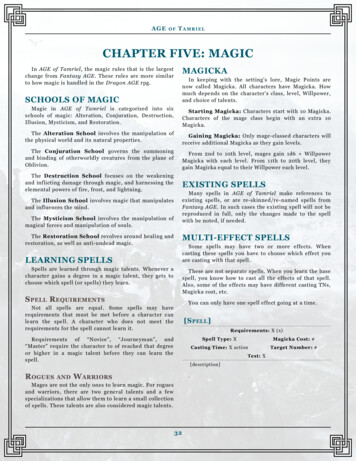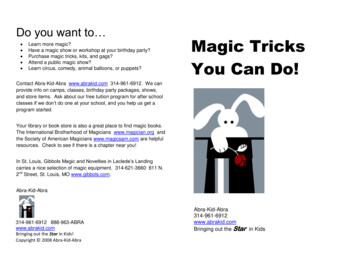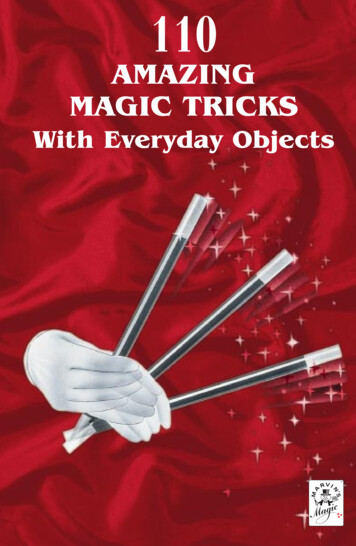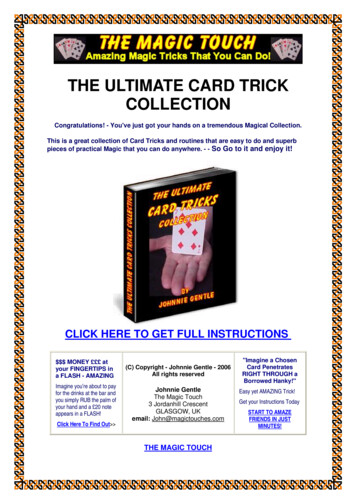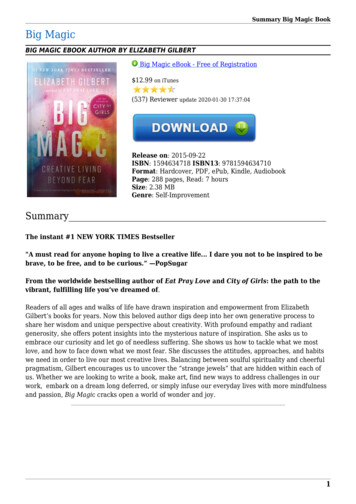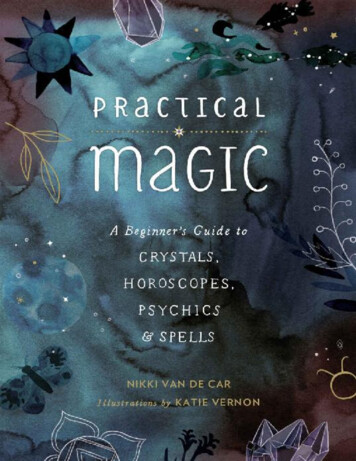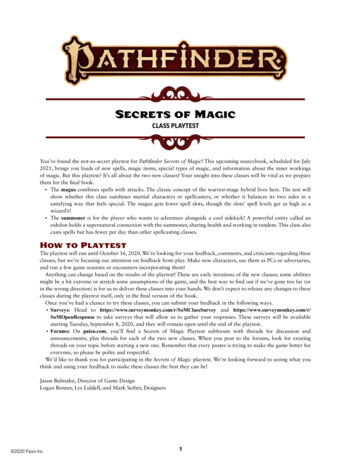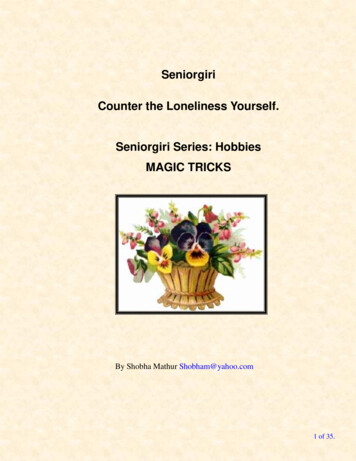
Transcription
SeniorgiriCounter the Loneliness Yourself.Seniorgiri Series: HobbiesMAGIC TRICKSBy Shobha Mathur Shobham@yahoo.com1 of 35.
Navigate The Document EasilyFor Adobe Acrobat Reader, please click the Book mark icon on theTool Bar. This will open a Bookmark panel to the left of thedocument. It has a list of all headings. Here you can click on anyheading to go there directly.For other PDF readers, if there is no such icon, please look for BookMark panel under Menu bar headings. It might be under View orWindows.2 of 35.
HelloWhen was the last time you did Something for the First Time?Do it now.This is the age to enjoy whatever you wanted to do before but had notime to do till now.You are your own best friend.You do not need any one’s permission to learn new crafts or pursuenew hobbies.Remember You are not competing with anyone. You do not have to prove anything to anyone. You have to suit only your pace of doing thing,Last but not least Be proud of yourself for all and any achievement. Enjoy and Enhance your life and abilities.3 of 35.
THIS IS HOBBY HELP SERIES FORSENIORS.I am compiling a series of things to do - what to do to counterloneliness, in addition, how to go about it.This is about Magic tricks. By its very nature this is for beginners.Once you get the hang of it you may try advance tricks later.I have tested all the links mentioned. As on February 2010, all linksare secure, correct and working.You should look for more as you surf. You may find many that willsuit to your needs. This is just a first step.Please feel free to share this with anyone you like.4 of 35.
MagicIntroductionThe word magic has its roots in Greek Magos ( magicians).Magic has two different connotations.MagicHistorically magic has been associated with mystical incidents, and isalso known as sorcery.This kind of magic involves spells, rituals, charms,clairvoyance, and other such paraphernalia which can be usedto heal or harm a person. It is what is called “Black” or “White”Magic. Recently Harry Potter has popularized this concept.Many cultures have versions of witches, wizards, warlocks,sorcerers, witch doctors, shamans, and other people who couldcontrol paranormal powers for assorted tasks. They wererevered and feared for their abilities. It was believed they couldheal as well as cast spells even to change weather, cause famineand sickness.Even today in Africa and Latin America voodoo is a religion!In western society also training for witchcraft is gainingground.In India also Tantriks and local Ojhas perform spell relatedtasks – specially for “Evil Eye” ( Nazar Lagana) .Magic TricksAnyway, this article is not about this kind of supernatural Magic.This is about the second type which is pure entertainment and hasnothing to do with any mystical subject.This kind of magic is a field where people create illusions or effects.Skilled magicians can seem to make flowers bloom in mid-air, cutwomen in half, conjure rabbits from hats, escape from sealed vaults,vanish from one place and appear in another.5 of 35.
There is no supernatural force involved in this, only focused work andpractice.If you are of gregarious nature, like to surprise people with pranks andshowing off, try magic tricks.There are many professional magicians, who perform big time onstages and need a lot of gear and paraphernalia. Our own P.C. Sarkarand his son are quite famous.But you do not have to go to that level to enjoy magic. Just to showmagic tricks to your grandchildren and their friends, in your localsocial gatherings, senior clubs will be rewarding enough.You do not even need many tools. Most basic tricks are done withpacks of cards, coins, handkerchiefs, ropes and other household items.Only thing required is practice for a flawless presentation and gift ofgab.Many magic kits are available for children from very basic to quitecomplex. Maybe you could try from that. All instructions are with thekit.There are shops also which sell “magic” tricks. I have given somelinks for online shopping.There are many free lessons and tutorials available on the net forhome or armature magician.There are some free e newsletters also which you can subscribe to.NoteThis is a hobby article, so I am only including very basic andbeginner’s items. Anyone want to go beyond this can surf for advancelessons.If you become really efficient, it can also be a source of income. Butfor that you need a different grade of tricks and props.6 of 35.
History of Modern MagicMagic as we know today in only about 150 years old.Robert-Houdin of France introduced many stage illusions. He is calledthe father of modern magic. By profession a clockmaker, he was bornJean-Eugene Robert-Houdin in Blois, France, in 1805. His debut as amagician was in 1845 in Paris.He was the first magician to use electricity; he perfected thethought-transference trick; and he used common objects tocreate illusions instead of complicated pieces of machinery.He also denounced magicians who claimed psychic powers orsupernatural help for their tricks. Robert-Houdin is the manfrom whom the American magician Harry Houdini took hisname a generation later.In 1856 the French government sent Robert-Houdin to Algeriato discredit native priests who were using magic to fomentrebellion. Robert-Houdin used one of his best tricks to deceivethem. He had an empty wooden box that anyone could lift. Ithad an iron bottom, however, and could be made immovable byturning on an electromagnet hidden under the stage floor. Withthis trick he was able to convince an audience that he coulddrain the strength from the strongest of men at will.English-born John Nevil Maskelyne was a noted escape artist. Alongwith his amazing escapes he perfected levitation rising from the stageseemingly unaided. In 1893 he teamed with master magician DavidDevant. In 1911 they published 'Our Magic', a major sourcebook onthe theory of magic. Maskelyne died in 1917, but Devant went onperforming until shortly before his death in 1941 at the age of 73.Before Harry Houdini, the most outstanding American magician andshowman was Harry Kellar. He traveled to many parts of the worldbefore settling in the United States in 1884. In 1908, he sold his showto Howard Thurston. Thurston was from Ohio and was touring theworld doing mainly card tricks when Kellar met him in Paris. After hetook over Kellar's show he made it the largest magic extravaganza tothat time. For more than 20 years he toured with a three-hour showand became known for his large stage illusions such as the "floating7 of 35.
lady." In 1931 he shortened his program to appear as a stage attractionin movie theaters.The English magician P.T. Selbit (born Percy Thomas Tibbles) gainedfame for two unusual illusions.In 1914 he walked through a brick wall on stage. This illusionwas repeated in 1986 when David Copperfield walked throughthe Great Wall of China in a performance that was seen ontelevision.In 1921 Selbit became famous for his trick of sawing a womanin half.http://lookd.com/magic/emergence.htmlThe World Of MagicMagicians makes the impossible possible, the visible invisible, andthe unbelievable believable. It is a both an art and science ofentertainment and illusion.Learning and practicing magic tricks, and perfecting them are anenjoyable activity in itself.Magic is a performing art. You can read about magic tricks frombooks and videos, but to learn you have to do it. Whether your focusis in cards, coins, magic rope routines, manipulations, cups and balls,or impromptu magic, you must practice till no one can guess what youare up s/featured3.jpg8 of 35.
Different Types of Magic TricksThere are thousands of tricks. They are classified three ways,according to :Where they are performed.What is performedHow it is performedClassification by place of showChild MagicChild magic is to entertain children. These must be quick tricks aschildren cannot concentrate long. The magician should use color fullprops and animals.Close up magicThis requires least skill and anyone can do it with just a little practice.Simple everyday things such as a deck of cards, key chains, somesmall balls or coins are used. This kind of trick proves that the hand isfaster than the eye.This is performed for a small group of people within a small space.The magician will be sitting or standing with the people.This is also known as parlor magic.At the most the magician might need a covered table.Stage magicHere the magician is at a distance from the audience and is performingtricks for large crowds. Tricks are done on a large scale so thateveryone in the audience can see and know what is happening.9 of 35.
Sawing a woman in half, levitating in air, turning a lady into a lion,and making large objects to vanish are all stage magic. Stagemagicians are also great entertainers so that they keep the entireaudience involved during the show.Street magicIt is performed outside on the roads. Very popular in USA.Street magic often includes sleight of hand tricks, although a varietyof magic is performed this way.One of the most famous current-day street magicians is David Blaine,who performs a wide range of card tricks, disappearing acts, and evenlevitation on the street.Classification by What is performedProductionSomething comes out of nothing - pull rabbits out of a hat. Somemagicians generate a wide selection of objects out of thin air.appearing out of nowhere in a puff of smoke is also production.VanishingThis is the opposite of production. The performer makes an object, anassistant and himself to disappear.David Copperfield made the Statue of Liberty disappear and P.C.Sarkar had the Taj Mahal vanish.TransformationTurning one thing into another - a jug of milk into a white pigeon.Cards change color. Transformation is a combination of vanishing andproduction.The performer makes one object disappear and make another appearcreating the illusion of transformation.10 of 35.
RestorationAn object is destroyed and then restored to its original state. Anewspaper is torn into pieces, an assistant is cut in two, and thenrestored.TeleportationAn object is moved from one place to another.Keith Barry performed a combination of restoration and teleportationwhen he burned a bill with a volunteer's name on it and laterteleported the bill inside the lighter the he used to burn the billoriginally.EscapologyIt is all about escapes from handcuffs, cramped and locked places.Harry Houdini's was most famous for this.LevitationIt is making something or someone float, sometimes the performerhimself.Criss Angel did an amazing levitation performances when he floatedfrom one building to another.PenetrationThis illusion makes a solid object appear to pass through another.Could be a the performer passing through glass, rings linking andunlinking, swords appear to impale an assistant inside a box, etcMentalismThe magician shows that he possesses special abilities to readthoughts, predict events or control the minds of others. He can predicta card or a number that the audience choose.In front of live audiences, mentalists will recreate drawings done byaudience members that are unseen to the magician, but visible to theaudience. They will also read the minds of strangers and perform anarray of amazing mental tricks11 of 35.
Mentalist feats can be done with a large or solitary audience, on astage or close-up.Classification by how it is doneAll these are different techniques used in showcasing magic. They canbe used on their own or in combination of two or more.Magic is all about illusions that mystify and that are kept secret. Aperformer has to understand basic rules and practice them .MisdirectionMagicians use misdirection to convince the audience that they aredoing something incredible. The performer deliberately acts in such away that the audience looks not where they ought, but in an entirelydifferent direction.Smoke and mirrors were often used by early magicians and they arestill some of the most useful tools of the modern day magicians.Sleight of handThese are skilled hand movements where objects seem to appear anddisappear in the hands of the performer.Sleight of hand tricks are used with a variety of objects, includingcard, coins, balls, and other objects.ShowmanshipMake the audience think that there is a lot of effort in doing a trickeven if the trick is really l12 of 35.
How to begin?Previously, the only way to become a magician was to learn magic asan apprentice. Currently it is much easier. Books, Interactive CDROMs, Videos, and the Internet all have a wealth of lessons.Especially internet is a boon. There are free lessons, tips, and blogs ofpeer groups for support.Ready-prepared and basic tricks are available from magicshops, and most good toy shops.Learning magic on your own is not difficult. Step by step tutorialsabound both in text and visual format. Sleight of hand is best learnedfrom videos, as they show you exactly where to place your hands andhow to place the objects in your hands that you need.It is important to have a good knowledge of all magic principlesto become a successful magician.Magic is not learned just from books and videos, but through practice.Go and see a live magic show in your area, even if it is a children'smagician, to get a feel of how a magician performs. Try to work outwhether or how you will like to improve the show.You can also watch magic shows on the TV.kidsmagictricks.net/13 of 35.
Accessories and toolsYou will need some tools, but unlike other hobbies there are nostandard set of tools of trade. Depending on what you want to show,you will need the items.For close up shows it is better to take some items from the host,especially for coin tricks.Still, packs of cards, special handkerchiefs, may be a wand for effectscan be carried.A wand is a personalized stick supposedly a source of power and usedfor spells. (See Harry Potter!) Wands are generally made from wood,bone or metal. A typical wand is between 6-16 in (15-40 cm) long,and carved or decoratedWe somehow always associate a top hat with a magician – the mostfamous trick of producing rabbits from it! So if you can invest in amagician’s costume with a hat, it will give you instant recognition! Orgo Indian and wear a turban!Each trick will need its own set of items, and that you have to carryinconspicuously.Later you may like to make your own props for the shows.You should try to specialize in one kind of trick instead of trying s/f/f7/Magic.png14 of 35.
Psychology of MagicWhen you perform all your friend will be eager to catch you off. It isyour job to prevent them. That is where knowledge of the audiencepsychology comes handy.Misdirection / distractionIt is vital that you keep the audience from noticing what is actuallyhappening. If you can control audience's attention, either by talking orgesturing, you need only some skill of hand and very little apparatus.Distraction of the mind is as crucial as distraction of the eye.The attention is drawn away from the method. In a mechanicaltrick, for instance, the magician talks about skill of hand ormagic words anything but mechanics.Robert-Houdin was very adept at misdirecting an audience, ashe proved with his wooden box that could not be lifted by thestrongest of men.TimingIn the psychology of magic timing is crucial. How an action isperformed and the time, at which it is done, a magician can impressaudiences with the doing or make them fail to notice that anything atall is being done.Sleight of handSleight of hand must be done slowly and gently. You can continue totalk about speed of the hand to mislead spectators so they will watchalertly for some swift movement. They thus fail to notice the normal,easygoing motions by which the trick is really done.The most necessary skill to attain great sleight of hand is the ability topalm an object undetected.15 of 35.
You can perfect this with much palming practice. Conceal smallobjects such as coins during your everyday, normal activities. Practicepalming a small object (in either or both hands) while writing, eating,watching TV, walking around, or doing anything else. As youpractice, pay attention angles.Soon, no one will detect that you have an object hidden in your hand.Before long, you can conceal various objects comfortably with noself-consciousness. Eventually, it will become almost natural to you.After that, you can palm objects more confidently, boldly, andsuccessfully.Master Your PresentationPractice your presentation. The most effective routines are simpleeffects to which your audience can relate and understand. Where isthe magic if your audience doesn’t understand what happened? Yourpresentation should be straightforward, simple, and easily understood.Watch Your AnglesAlways be aware of your angles. Consider carefully what everymember of the audience can see, otherwise they could get a glimpseof the object you think is hidden. The trick is exposed and the magicis gone.Look at themEye contact is essential. Look at each of your spectators in turn. Thismakes the audience believe that you are talking to them, and notthrough them.SecrecyNever reveal your secrets if you want to go on doing your shows. Anaura of mystery should hang about your movements. Chanting somemantra can add to ambience.16 of 35.
No repetitionDo not repeat a trick. When a trick is done for the first time, theaudience is amazed. Doing it twice will make the audience predictwhat will happen and the sense of wonder is lost.If an enthusiastic viewer pleads for you to repeat, counter withsomething like, “OK, in a minute. Right now, I want to show yousomething even more baffling,” and proceed to show a differenteffect.By the time you are finished with the second routine, they will be soamazed you can move on to something new.ConfidenceEven if you have stage fright, try not to show. You are the master andthey are going to be under your spell. Follow your personality. Somelike to chatter, some do buffoonery and some just like to work silentlywith grand gestures. Do whatever makes you 07/08/21/science/magic span 600.jpg17 of 35.
Starting the journeyTo begin with, start with a deck of cards, and coins. They are cheap,easily available and there are thousands of tricks available. There areeven special trick cards obtainable!Most card tricks make use of sleight of hand techniques, still there arealso a large number of self working card tricks that are very easy toperform and require no skill at all.There are many links later to look for tricks. Please check them outand choose some to learn. Download the video, or the text to read andunderstand first what is needed and how it is done.Then PRACTICE! PRACTICE! PRACTICE!When you think you have it right, practice some more in front of amirror. This will show any imperfections.Start with the real easy ones first to build up your confidence.When you’re starting out with magic, the best tricks to start with areones that don’t need complicated sleight of hand to be able toperform.There are some great card magic tricks that are good for beginners,which work because of the way the trick’s method has beenconstructed.18 of 35.
The following link is a very good one for beginners. It shows you howto shuffle a deck, how to make people choose a card and all sort ofother techniques. The graphic shows some of the tricks learnmagic.htm#s1Easy Magic Tricks for tricks/Easy Magic Tricksfor Beginners.htm19 of 35.
Kinds of TricksSelf workingAnyone knowing the secret or the science behind the trick canperform these tricks successfully every time.Passing a quarter through a dime-sized hole is one example of a selfworking magic trick. The magician bends a piece of paper with adime-sized hole in half, then places the quarter in the divided hole. Bybending out both sides of the hole, the quarter should fall throughwithout tearing the paper.Some magic tricks involving math or cards are also considered selfworking, because the order of the cards or the numbers does notchange.GimmicksOther magic tricks work through gimmicks.The objects used are modified in some way to guarantee a successfuloutcome.A gimmicked card may have two different suits, depending on whichhalf the magician chooses to reveal. A gimmicked coin may be riggedto bend in half and reassemble itself 'magically'.These are special tricks that you can buy.Another type of magic trick popular with audiences is the stageillusion. These magic tricks are often performed on a grand scale, withbeautiful assistants aiding the magician and elaborate light or musiccues guiding the action. Illusions are essentially based on tricking theaudience's sense of vision. These are beyond the scope of this hobbyseries.20 of 35.
Tips for learning and PerformingSet aside an hour or so a day for practice. Do it regularly, say threetimes a week, at the same time, and get into the habit of practicing.Treat your magic like studying for exams, and you can't go far wrong.Do not be in a hurry to read the description through, and immediatelytry to produce the result. Read carefully through first, and understandwhat is required to be done; after that, follow, with the hands step bystep, until it is certain that all is correct up to each point.With cards, this careful following of the text with the hands isespecially essential, and attention to it will save much time,trouble, and annoyance at the outset, when everything new willnaturally appear difficult, if not absurd.Don't perform a trick until you can do it with one hand behind yourback, blindfolded, and without having to think about what you'redoing.Practice in front of a mirror, so that you can see exactly what youraudience will see. This will enable you to spot any mistakes you maybe making.If you have a video camera or camcorder, then video yourselfperforming, which lets you see just how good/bad you actually are. Ifyou are not satisfied with your performance, then you know that youraudience will be too.Learn to do as many different types of tricks as you can, so that ifsomeone gives you a coin, you can do a trick with it, or if someonegives you a deck of cards, you'll be able to do a trick with that too.This is called performing 'Impromptu'.When performing with props, keep them clean and presentable at alltimes. Make sure your props work correctly before a performance!21 of 35.
First ShowOnce you have learned a good number of tricks, perhaps 10 or 12,then it's about time you started thinking about putting a short showtogether. 30 minutes is just right.The speech and patterInitially prepare, and learn by heart, a little set speech to begin with,and also the accompanying talk for each trick. When you are moreseasoned you may not need this. The first appearance before anaudience is in itself quite intimidating, without any additional problemthat you do not know what to say.You have to be careful that your talk is entertaining and not a lecture.I suggest during the first six months, write down everything you haveto do or say, accompanied by the minutest stage directions. Each handand foot should have its proper position at a given moment.Prepare the StageSet up a stage that could consist of either a piano bench or a smalltable with a sheet or table cloth. It makes it look more professional.Keep some flower vases on the corners of the table; it looks good andhelps hide the work view from public.Make sure by going around the seating arrangements that you can beseen, but your trick area is not visible. Also see there are no mirrorshanging behind you.Prepare the PropsGather all the paraphernalia that you need beforehand and carry in onebox.The usual props used by magicians include playing cards, hats,animals, a handkerchief, etc.Advance magicians use more complex personalized props.22 of 35.
CostumeYou will need full sleeve shirts and pants with deep pockets. A top hator turban gives instant celebrity status!For more advanced tricks specially made coats, cloaks, hats and pantsare used.The ShowA successful show has a beginning, middle and an end, just like anygood book.Always start off with a 'warm-up' which is a short but startling effectperformed by you, normally without audience help that gets youraudience into the swing of things.After the warm-up, perhaps perform a slightly longer effect, with lotsof good patter, and perhaps some audience interaction.When creating your routine, don't put two similar effects together ortwo long or two short tricks together.For example, if your first trick involves a vanish, then it's agood idea not to make the second trick a vanish also.Then again, if you can find a way to link two effects, forexample, using the flowers you produced in trick one as part oftrick two, then the show flows a little better.Pace yourself, and remember that variety is the spice of anyshow. Always finish with your most spectacular effect, as afinaleAs a general rule, the younger the audience, the shorter the showshould be. Always leave the audience wanting more.The best way to get started here is to show a few tricks to familymembers or close friends and judge their reaction. After you becomeconfident about performing for them, then you can think about doingshows for your local school, playgroup, or party.23 of 35.
Remember that each audience will be different. Children like differenttypes of magic than adults and each age group will have differenttastes.Remember that each different social class, age group etc. finddifferent things /01/web zapatero.jpg24 of 35.
Some simple tricksCard TricksThese are tricks where a chosen card changes place, comes out of itsown from the pack , or many variations of this theme. To be able to dothese you have to master sleight of hand – there are several poses youhave to learn.1. The pass.2. The false shuffle.3. The palm.4. The change.5. The slide.6. The force.To be able to do card tricks in a convincing matter you have topractice all these unstintingly. They may seem difficult at first,but practice will give you perfection.These set of techniques used to create illusions for card are alsocalled Legerdemain as well as sleight of hand.Legerdemain is one of the most difficult skills for the magicianto perfect, but also one of the most impressive.You can learn about them hereClassic magic .nethttp://www.classicmagic.net/tricks/7a.php25 of 35.
One excellent mentalism trickThis is a fantastic trick rsBesides card magic, there are other tricks a beginner can learn to doeasily. Here’s an example, which is a trick called ‘1089 MindReading’. This is an example of mind or prediction magic, and ifperformed well, it will definitely have your audience scratching theirheads, and wondering how you did it (be sure never to tell them thesecret)!To start with, you’ll need a book, a slip of paper, and an envelope. Inthe book, go to page number 10, on this page go 8 lines down, andfind the 9th word on this line. Hopefully this word is something otherthan ‘the’, ‘a’ or ‘and’ – if not, you might want to choose anotherbook! Write this word down on the paper, put it in the envelope, andseal it.In front of your audience, show them the sealed envelope, tell themyou’ve made a prediction, and then ask an audience member to guardthe envelope. Say that you’re going to get the audience to help youchoose a random number.Pick someone from the audience, and ask them to think of a 3 digitnumber, e.g. 487. Get them to reverse this, and subtract the smallerfrom the larger, so, here 784 – 487 297. Secondly, request theyreverse this result, and add together – so here 297 792 1089. Itmight be that at this point, they have 198 rather than 1089. If this isthe case, just have another step, ask them to reverse & add again, soe.g. 198 981 1089. This is a curious mathematical fact, takingthese steps with any 3 digit number will always give 1089.26 of 35.
Now it’s time to use that result. Hand the book to a member of theaudience, and say that the first 2 digits should indicate the page to turnto – i.e. page 10. Then tell them to use the 3rd digit to find the line onthat page – line 8, and the final digit represents the word on that line– word 9.Finally, it’s time to reveal your prediction. Ask the audience memberwith the book to read that word aloud. Then ask the other audiencemember you had guard your envelope to open it and show what waswritten on the piece of paper. The result – a fantastic display of mentalprediction!You can have a lot of fun doing this trick; just remember to practice itthrough a few times before performing for an audience. One thing youcould do to make it seem a bit more random is at the start, to throw asponge ball, or ball of paper into the audience, and ask them to pick asingle digit between 1 and 9. Then have them throw the paper in theair and get someone else to choose a second digit, and repeat this withanother audience member for the final digit. This draws out theperformance a little, and adds a bit more fun too. Remember you canonly perform this trick once in front of the same audience!Make a card vanish into thin air!http://kids.mysterynet.com/magic/Supplies You NeedOrdinary deck of cardsHandkerchief with a hemToothpickScissors27 of 35.
SetupTake a toothpick and match it upagainst the end of one of thecards. Take the scissors and cutthe toothpick so it's the same asthe width of the card. Poke itinto the hem of thehandkerchief. Make sure it won'tfall out.How to PerformTake the deck of cards and spread them out in a pile on the table infront of the audience.Bring ou
Magic has two different connotations. Magic Historically magic has been associated with mystical incidents, and is also known as sorcery. This kind of magic involves spells, rituals, charms, clairvoyance, and other such paraphernalia which can be used to heal or harm a person. It is what is called "Black" or "White" Magic.

